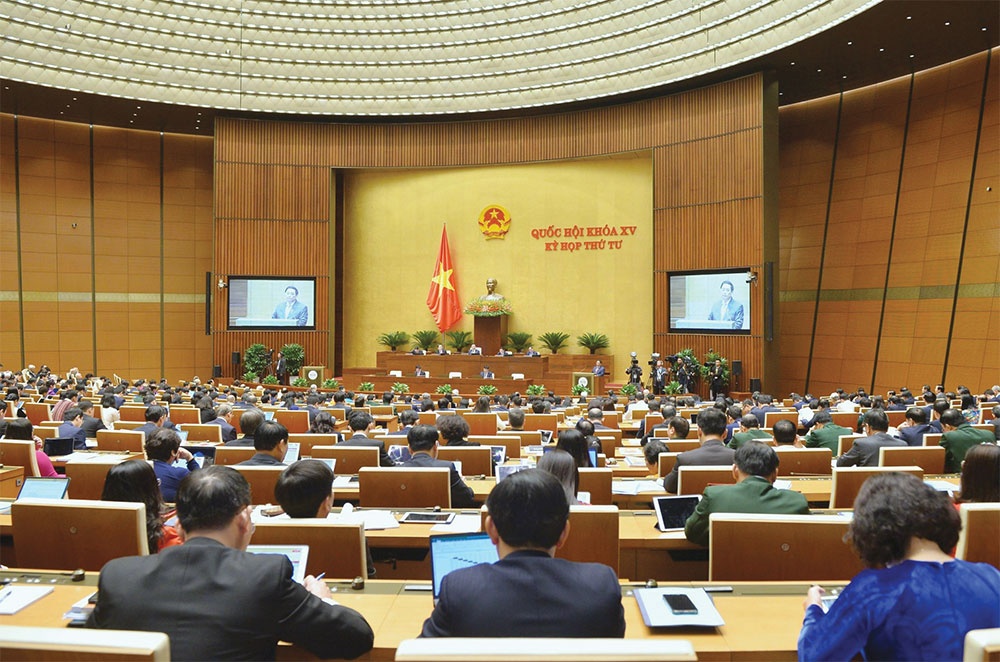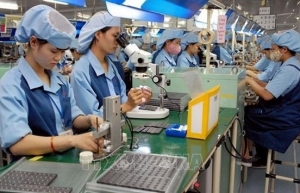Plenty still to do to stabilise businesses
Over the past few months, 40-year-old Nguyen Van Hieu in Hanoi’s Dong Anh district has been finding it more difficult to feed his family of five. His wife has not worked since late 2021 after the furniture company she was employed at went bankrupt.
Hieu had worked for a domestic electronics company located in the capital’s Quang Minh Industrial Park for five years. Nevertheless, it made staff cutbacks of 200 employees including Hieu, whose monthly income was about VND8 million ($350).
“The company had to reduce production caused by a drop in export orders from a number of European markets, and also from China, which has been the freezing business activities of many enterprises,” Hieu said.
Thousands of unemployed people like Hieu are commonly seen now in his commune. They used to work not only at Quang Minh but also at other similar parks including Thang Long, North Thang Long, and Dong Anh in the district. Other parks in Hanoi also include Thach That Quoc Oai, Phu Nghia, and Thuong Tin.
The pandemic plunged many labourers in Vietnam into woes last year, with an unemployment rate of 3.22 per cent, equivalent to 3.15 million people. Over 2.2 million labourers left their companies due to staff cutbacks for their localities, including 524,000 people in Ho Chi Minh City and 447,000 people in Hanoi.
In the first nine months of this year, Vietnam’s unemployment rate for those of working age in Q3 is estimated to be 2.28 per cent – down 1.7 percentage points from the same period last year. The 9-month rate is 2.35 per cent – including 2.88 per cent in urban areas and 2.02 per cent in rural areas. The unemployment rate of those at 15-24 years old in Q3 is 8.02 per cent – up 0.39 percentage points on-quarter and down 0.87 percentage points on-year. The 9-month rate is 7.86 per cent – including 9.65 per cent in urban areas and 6.91 per cent in rural areas.
Also in the first nine months of 2022, the number of enterprises that withdrew from the market was nearly 112,700, up 24.8 per cent on-year.
 |
| The fourth session of the 15th National Assembly will discuss ways for the economy to reap higher growth |
Major qualms
The government reported to the National Assembly Standing Committee (NASC) that there must be urgent solutions to “solve the shortage of labourers in urban areas, industrial zones, and big economic zones”, and “importance must be attached to effectively implementing policies on social security, and assisting labourers with housing rental.”
“The domestic labour market remains in difficulties. There have been labourer shortages in a number of areas, focusing on the industries of garment and textile, electronics, and wood processing,” said a government report to the NASC.
Especially, the reports also underscored that Industry 4.0 is boosting digital transformation and application of high technology, while Vietnam’s labour quality fails to meet the demand for high skills.
“This may drive the economy into a middle-income trap and the country will not be able to escape from the existing model of labour-intensive development and low technology,” said Minister of Planning and Investment Nguyen Chi Dung. “Moreover, there may be a foreign direct investment wave flowing back to its original nation due to Industry 4.0 and Vietnamese labour costs remaining unattractive. This will surely affect employment opportunities for domestic labourers.”
The government warned that if no solutions are taken, the economy will not only continue seeing many people unemployed but it will also be affected in terms of production and exports due to disrupted supply chains.
At the sixth plenum of the 13th-tenure Party Central Committee held over two weeks ago, Party General Secretary Nguyen Phu Trong called for efforts to maintain macroeconomic foundations and stimulate growth to prepare for all probable scenarios, especially in later 2022 and 2023. “Pressure in inflation, interest rate, exchange rate, and the risk of depression of the global economy remains the biggest challenge for us to ensure macroeconomic stability, control inflation, and ensure big balances of our economy,” the Party leader stressed. “Production and business activities, despite some recovery, remain in difficulties caused largely by strong fluctuations in prices of fuel and input materials, high increases in production costs, and a reduction in export-import markets.”
Concerned over headwinds, the government has suggested that the economic growth for 2023 should be about 6.5 per cent and per capita GDP should be $4,400. This year, it expects the rate to be about 8 per cent.
“The economy is now quite open to the world. Thus any fluctuations in the global market such as high inflation, high prices of materials, and supply chain disruptions can have negative impacts on the country’s macroeconomic stability, economic growth, inflation, and people’s life and incomes,” said Minister Dung.
According to the General Statistics Office, Vietnam’s total export-import turnover last year was $668.54 billion, or 1.81 times higher than the GDP of $368.68 billion. Total export revenue reached $336.31 billion, up 19 per cent on-year, and import value hit $332.23 billion – up 26.5 per cent on-year.
Singapore-based ASEAN+3 Macroeconomic Research Office (AMRO), which has just forecasted that Vietnam’s GDP growth will rebound to 7 per cent in 2022, underlined challenges facing the country’s economic outlook. “Key external risks stem from global supply chain disruptions, flare-ups in more vaccine-resistant COVID-19 variants, tightening of financial conditions in advanced economies, and elevated global oil and food prices related to geopolitical developments,” said AMRO in a statement. “From a longer-term perspective, the pandemic may have widened inequalities across high- and low-income earners, between exported-oriented and domestically oriented firms, and between large corporations and small- and medium-sized enterprises. In addition, lasting scars from the pandemic may undermine growth potential over the medium to long term.”
With these risks, the AMRO predicted that the Vietnamese economy will grow and 6.5 per cent in 2023.
Strong remedies
It is expected that providing more support for struggling enterprises and unemployed people in Vietnam will continue heating the 15th National Assembly’s (NA) ongoing fourth session, scheduled to end on November 15. The legislature will discuss the results of updated reports on implementing the socioeconomic development plan and state budget in 2022. Especially, the NA is also expected to debate how to assist enterprises hurt by the health crisis and provide sufficient jobs for unemployed people.
NA deputy Vu Tien Loc representing the northern province of Thai Binh, stressed that businesses still face big difficulties, especially smaller groups operating in service and production.
“In the service sector, besides financial, banking, and insurance services, other types of services are facing massive woes. Many enterprises in the sectors of tourism, aviation, restaurants, hotels, and transport are still weak. It is likely that many of these enterprises will be unable to recover after the pandemic ends if no more practical and strong support solutions are taken,” said Loc.
The government has ordered authorised agencies to “closely follow and make forecasts on the developments of fiscal and monetary policies of big countries and those who are trade and investment partners of Vietnam”, and to “frequently update scenarios on economic growth, inflation, credit quotas, and big balances so that the government can take the initiative in economic monitoring”.
Especially, the NA is asking the government to boost the implementation of the $15 billion Programme on Socioeconomic Recovery and Development, which remains slow. The programme covers numerous initiatives to support enterprises and labourers.
However, like many unemployed people, Nguyen Van Hieu in Dong Anh district lamented that he does not know how to benefit from the government’s pro-labourer and pro-enterprise initiatives. “I have heard about the packages in the media. Several times I have talked with the authorities in the locality, but they say they do not know much about the packages,” Hieu said.
 | Unemployment insurance fund to soon complete payments for COVID-19-hit employees More than 339,000 employees affected by the COVID-19 pandemic have received a total of 963 billion VND (41.12 million USD) from the unemployment insurance fund as of 5:30 pm on August 25. |
What the stars mean:
★ Poor ★ ★ Promising ★★★ Good ★★★★ Very good ★★★★★ Exceptional
 Tag:
Tag:
Related Contents
Latest News
More News
- Businesses ramp up production as year-end orders surge (December 30, 2025 | 10:05)
- Vietjet chairwoman awarded Labour Hero title (December 29, 2025 | 13:06)
- How to unlock ESG value through green innovation (December 29, 2025 | 10:03)
- AI reshapes media and advertising industry (December 29, 2025 | 08:33)
- FPT and GELEX sign deal to develop blockchain tech for global markets (December 29, 2025 | 08:29)
- Vietnam’s GDP forecast to grow by 9 per cent in 2026 (December 29, 2025 | 08:29)
- Women entrepreneurs are key to Vietnam’s economic growth (December 29, 2025 | 08:00)
- Vietnam's top 500 value-creating enterprises announced (December 27, 2025 | 08:00)
- The PAN Group shaping a better future with ESG strategy (December 26, 2025 | 09:00)
- Masan Consumer officially lists on HSX, marking the next phase of value creation (December 25, 2025 | 13:20)























 Mobile Version
Mobile Version